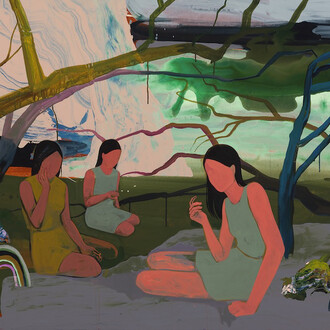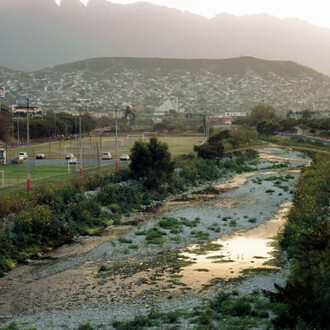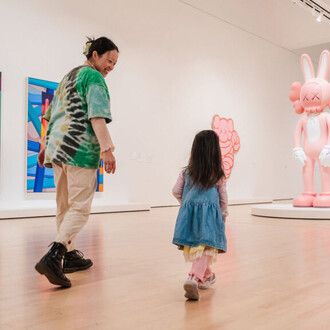Tint is pleased to announce The poetry of wood, featuring works by Alex Garcia and Catherine Mackey. Both artists explore the inherent beauty in wood in all of its stages, from shouldering structures to piles of debris. Mackey’s barn paintings highlight the beautiful chaos of the “pile”, but also the variegated patterns and colors created by re-use and weathering on the siding of barns not yet fallen. Garcia salvages wood from similarly decrepit barns and re-uses them to create three-dimensional works that celebrate all facets of the wood, in texture and color. Underlying both artists’ work is an ode to the history of the structures and the lives of the people connected with them.
Mackey’s current body of work focuses on barns in California, where the proximity to San Francisco allows her to revisit favorite structures every year to witness the movement of their collapse as a stop-motion animation. Each year, the architectural framework is diminished, and the fallen siding and structural elements lie scattered on the ground. To Mackey, the pile of fallen wood is as beautiful as the remaining structure.
In Mackey’s hands, these barns come to life. They are exhausted structures, metamorphosing into skeletons surrounded by their scattered memories. These old, weathered pieces of hand-hewn wood, with their slots and peg holes, have worked for years as an architectural team to create shelter and protection for crops and livestock. Now abandoned due to agricultural processes that have rendered them obsolete, these rural wooden structures succumb to the forces of nature and decay. Their physical decline is gradual, and the slow movement of collapse has a graceful beauty as roofs give way, walls detach and tumble, and bent frames are exposed in beautiful transparency.
The palpable sadness of lost livelihoods emerges through Mackey’s signature use of old street posters beneath and amongst the painted surfaces. These printed announcements of entertainments, events, and products, which come from walls of several different countries, remind the viewer that, over the years, people have used these places - not specific individuals but humans, whose needs and desires are essentially the same everywhere.
Similarly, Garcia’s works celebrate the inherent beauty in old wood, and tell the story of the structures and the lives behind them. Several of Garcia’s works in this exhibition are made from salvaged wood from the Straus Family Ranch in West Marin. The Straus Family Ranch was founded in 1941 by the early environmentalists Ellen and Bill Straus. Sadly, by 2013, the state of the ranch had deteriorated. Ellen and Bill had died, and their three children were no longer living there. The beautiful homestead was crumbling apart: the house was severely run down, the barn falling down and the land poorly managed. Faced with the very real possibility of losing the ranch, the children came together to save their family farm. In 2017, Garcia became involved in rebuilding the barn as part of the rehabilitation of these historic buildings. This was a project in which Garcia was able to use both his skills as an architect and artist. The wood that was unable to be incorporated into the new structure did not go to waste. Garcia breathed new life into the decaying wood by turning it into art.
Alex Garcia is an Argentinian artist currently based in San Francisco. He studied architecture at the University of Buenos Aires. He then practiced architecture in Los Angeles for a year before moving to San Francisco in the 1990’s, where he continued to practice architecture.
As an evolution from his architectural vision, Garcia’s artistic career began with furniture design more than 20 years ago. His first tables were made of reclaimed wood. Soon he discovered the joy of playing with a wide range of materials, including a combination of wood, metal, resin, glass, and more eclectic ingredients. His increasingly elaborate compositions combined his own stains with unique effects on wood.
The natural next step was to move his ideas to walls, where he began to explore and expand shape, scale, and form. Garcia’s art is an intersection of complex textures, bold colors, function, and beauty. He breathes new life and new meaning into discarded and reclaimed materials. The combination of textures, colors, and dimensions evokes nature in its pure, controlled, yet fanciful expression.
Garcia’s artwork can be found in both private and public collections, including Kings Crossing Community Housing, San Jose; Stanford Medicine Children’s Hospital; IBM Blockchain Innovation Gallery, NY; and Park 55 Hotel, SF.
Catherine Mackey’s move from a career in interior architecture to a life as a full-time artist coincided with her move from London to the Bay Area in the late nineties.
Her creative focus has turned away from highly designed spaces toward pragmatic architecture: buildings shaped by the necessity of manufacture, industry and – more recently – agriculture. She explores the demise and abandonment of structures no longer suited for today’s industries, and she searches for the accidental “moments” of beauty caused by their neglect and decay. At a surface level, these moments include the rust on an old sea-wall, the decay of wooden pier structures, and faded signage advertising products and businesses of the past. On a deeper level, these moments include the structural reveal which happens during the demolition process, or during the slow collapse of buildings as seen in her recent work with agricultural barns.
What all of Mackey’s work has in common is her interest in the history of the structures and the people who used them. She discovers forgotten stories told by layers of construction scars, signage, and abandoned artifacts. Over the years, she has collected old signpost templates and transcribed fading advertising signs – both of which she regularly uses in her work. Because of the prevalence of posters, especially in urban environments, Mackey also began to use this material in her work, adding a layer of narrative beneath and between the layers of paint. She now collects fragments of posters from streets wherever she goes in the belief that people’s stories are essentially the same wherever they live. The addition of these fragments, some of which peek through the paint and some which shout their presence, reminds us of ubiquitous layered narratives and allows for a more tactile viewing experience.
Mackey lives in San Francisco and works from her studio in a converted mayonnaise factory in the Mission District. Her work can be found in homes and offices across the US and Europe, and as far afield as Australia and China.















